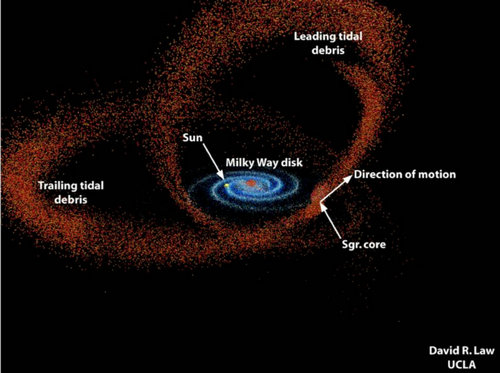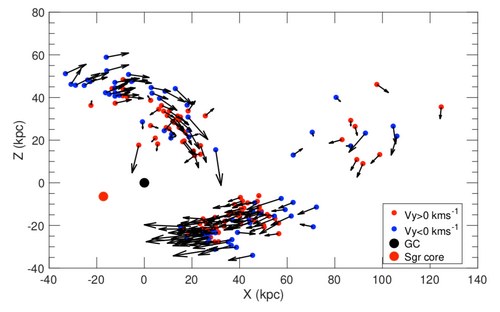Recently, a group of young scientists from National Astronomical Observatories of Chinese Academy of Sciences (NAOC), with Dr. LI Jing, LAMOST Distinguished Young Researcher at Center for Astronomical Mega-Science (CAMS), as the first author, used the M giant stars detected in the LAMOST DR4 data combined with the Gaia DR2's precise proper motion first depict the precise three-dimensional orbital distribution of the Sagittarius stream. This result has been published in the Astrophysics Journal (2019, ApJ, 874, 138).
The M giant stars, at the top of the red giant branch in the HR diagram, are very bright. They are almost at the end of the stagein stellar evolution and have exhausted most of the hydrogen inside the star. The M giant starsconsist of a huge hydrogen envelope with a radius up to 1AU (about 215 solar radii). The large radii makes them with high luminosity and are easily detected even at pretty far away distances. So M giant starsare a powerful tool for tracing the metal-rich structures in the Galactic halo.
In the previous studies, a large number of photometric surveys'data detected the member stars of the Sagittarius stream. However, most of the detections lack redial velocities. The LAMOST provides large number of spectra data. Using template matching method, Li Jing et al. selected about 30,000 M giant samples from LAMOST DR4 and used them to detect the Sagittarius stream star. By combining with Gaia DR2's precise proper motion, the spatial orbital distribution of the Sagittarius star stream is depicted for the first time in three dimensions, and the stream is tracked at a distance of 100 kpc from the sun. And for the first time, the Sagittarius stream is analyzed in the energy angular momentum space.
The Sagittarius Stream is formed by the collapse of the Sagittarius dwarf galaxies attracted by the potential of the Milky Way. Since this event has just occurred in the past few billion years, this structure is quite remarkable in space, like a red-flame dragon flying in the sky, crossing the entire Milky Way from south to north. Obtaining the detailed three-dimensional orbital distribution of the Sagittarius stream can help us effectively restore the interaction and merger history between the Galaxy and dwarf galaxies. This will offer strong constraints on the gravitational potential of the Milky Way and the star formation history, which is one of the key points to perfect the formation and evolution of the Milky Way.

Fig 1. Spatial distribution of the Sagittarius stream

Fig 2. Spatial distribution of the candidate members of the Sgr stream

Address: 20A Datun Road, Chaoyang District, Beijing, China code: 100012
Tel: 010-64888708 E-mail: naoc@nao.cas.cn

